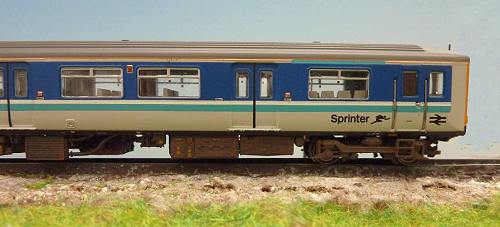Graham Farish Class 150 Sprinter Diesel Multiple Unit
This is one of the models produce under Bachmann's ownership and the detail is superb. It can run very slowly and quietly. It is difficult to see how it could be improved, but there are three areas I have tackled. In two of them, I have used items provided by the manufacturers who had anticipated that users would like to improve their models.
- Removing the ugly couplings at either end.
- Reducing the gap between the coaches.
- Weathering the underframe.
The couplings
I intended running the unit as a short 2-car train and did not need coupling at either end so the ugly large Rapido coupling at either end could go. The couplings just need a sharp tug to remove. With the set, Graham Farish supply dummy BSI couplers and snowploughs for the ends. Snowploughs seem to have not been fitted in the early days and the pictures of class 150s in Regional Railways livery do not show the snowploughs, so I have not fitted them. The BSI couplers are tiny and a fiddle to fit. I found it necessary to put a 1 mm drill through the fixing hole to enlarge it and then fixed the coupler with a dab of superglue on the end before pushing it home. I held the coupler in a clip as my fingers are too big for this fiddly operation.
The large gap between coaches
The original gap (left) and after modification (right).
The gap between the two coaches is excessive. With the pack of goodies supplied are some shorter couplings. The image on the right is the result of using one short and one standard coupling - a distinct improvement. I also tried two short couplings which brings the gangway connections very close together - however it would not go round 9" curves. There are no buffers to foul up but the exhaust pipes cause problems.
The coaches on the 150 are considerably longer than the class 101 and so the problems of small radius curves are more significant. The misalignment of the gangway connections when the unit goes from straight track to a 9" radius curve is frightening and therefore I did not attempt to fill the gap with a gangway connection extension.
Weathering
Multiple units are regularly washed in a bigger version of the automatic car wash. This does not touch the underframe and bogies which retain their dirt and eventually acquire a coat of rust. This is apparent in all photos of 150s except when they are new or refurbished. So in weathering, I have kept the roof and sides clean but given the bogies and underframe components a coat of dirt/rust with an earth-like colour (Nutmeg - a Wilkinsons Testpot). Another feature seen is a touch of soot on the roof adjacent to the exhaust pipes.

References
Article dated: 20/07/2011

